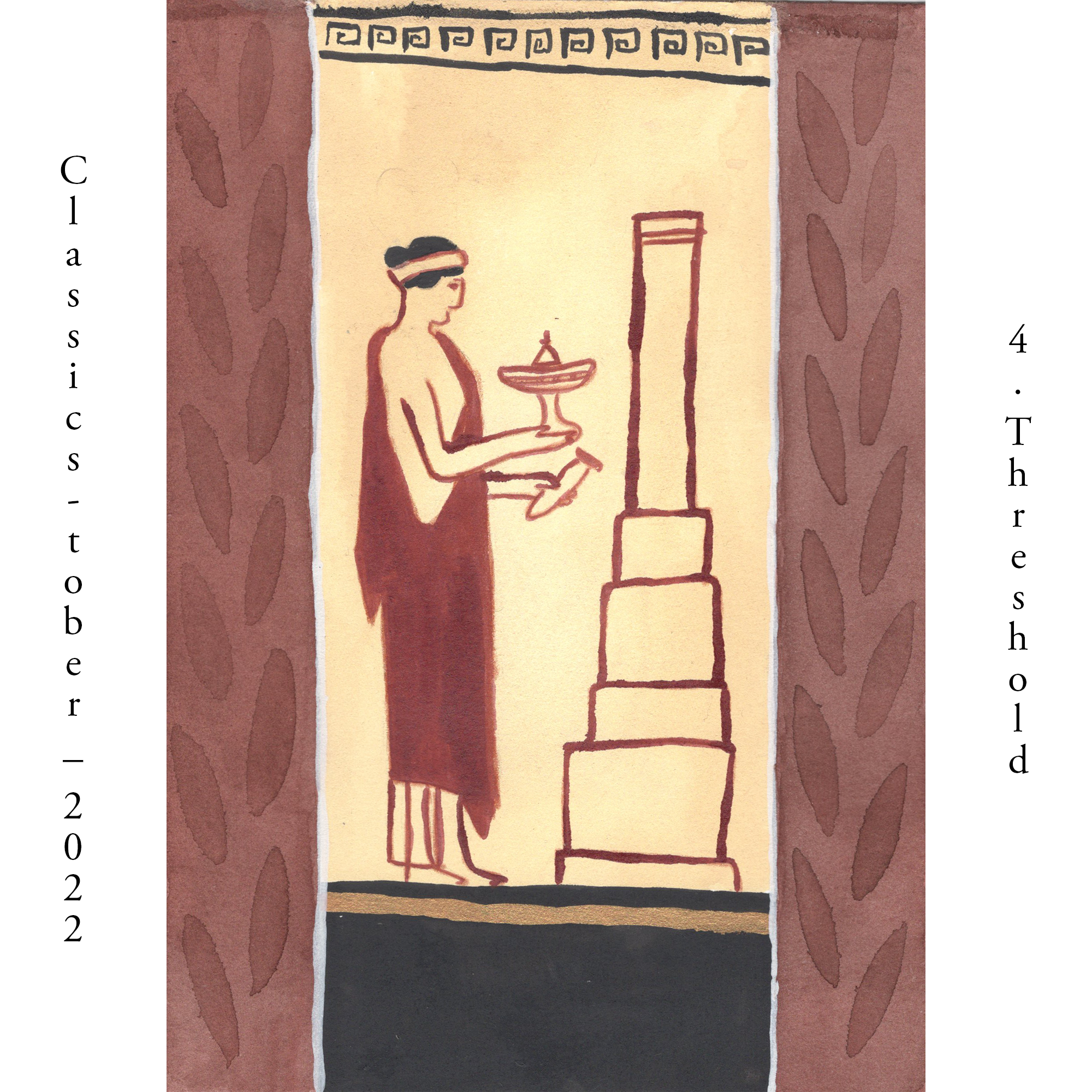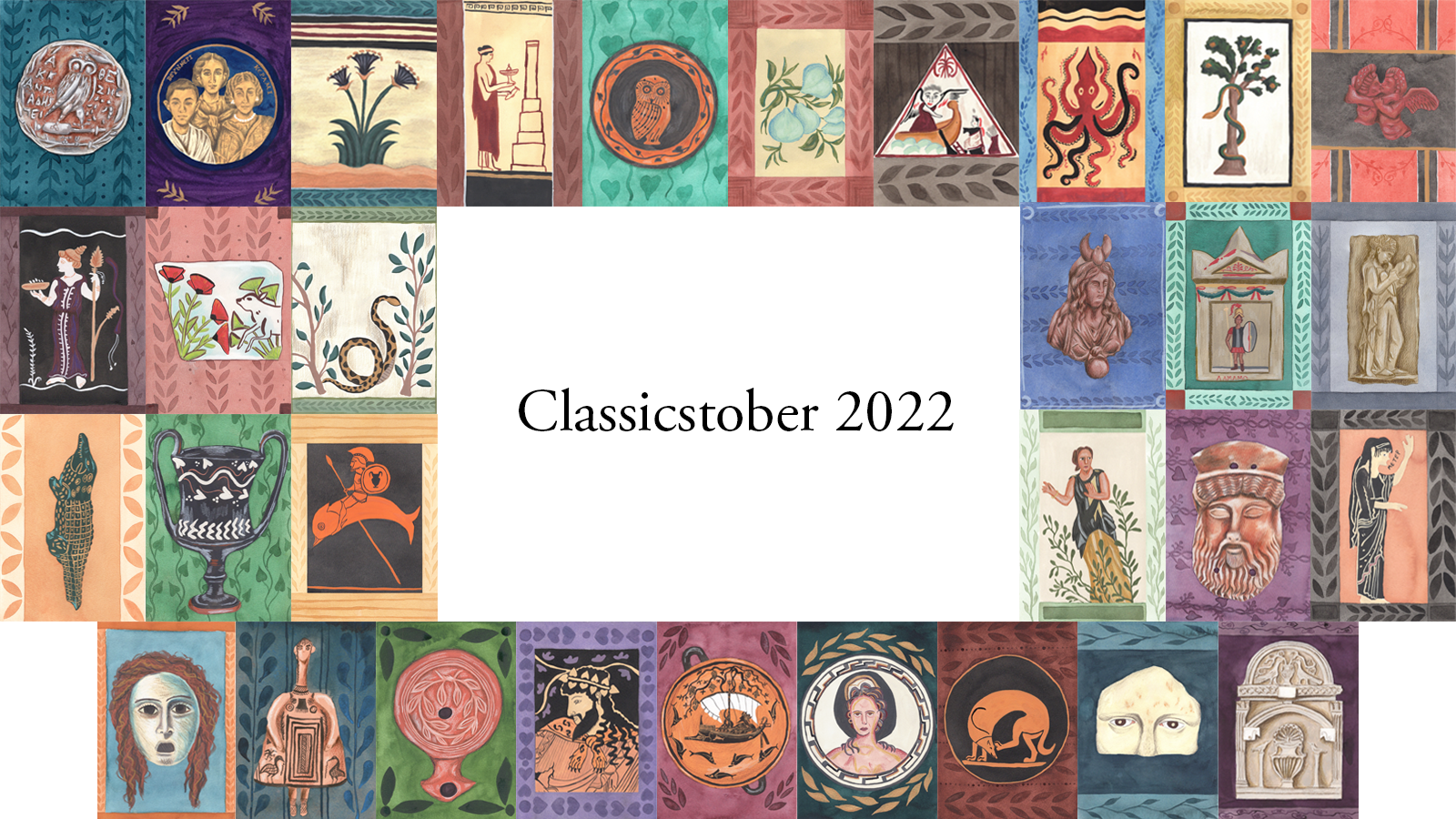I did it!
This is the first year I’ve ever completed a September art challenge (although it admittedly took me a /little/ longer than expected for me to crawl over the finish line, but I did)! I’ve had so much fun with these classical prompts provided by Jenks, please check out her linked website.
I tried to keep some consistency between each design and decided to base every image on an actual ancient artifact, rather than making up completely new scenes (maybe I’ll do that next year…). Admittedly, in the chaos of an illustration a day (for the most part), there are a couple that slipped through the net of potential non-ancient origin, but these will be indicated below. I also tried to follow a similar design style throughout the series whereby the main image would be painted in gouache, with details being added with more solid blocks of gouache and coloured pencil. I added a watercolour background with leaf details to the first image and ended up carrying that motif throughout the whole series, with slight variations on the leaf designs.
I have tried to research each artifact as best I can and have provided the provenance of each item, along with a link so you can see the original (I was going to add images directly to this page for comparison but then I realised I would absolutely get copywrite claimed). However, from many an undergrad experience, I’m sure some of my dates or descriptions aren’t precise enough so please do let me know if you spot an error so I can amend it!
Illustrations for Sale
If really like any of these illustrations, I have digitally cleaned up each image and finally opened a Redbubble store where you can purchase a variety of products. I will also be adding some of the originals to my main shop soon!


Athens mint, 135/134BC
N/A
This was a favourite coin of mine while I was studying my Hellenistic Worlds module for my BA, I found the amount of crammed-in letters very amusing.
Miniature multi-portrait on a gilded glass medallion with the Greek script ‘ΒΟΥΝΝΕΡΙ᾽ and ᾽ΚΕΡΑΜΙ᾽
c. 3rd Century AD
Museo di Santa Giulia. Brescia, Italy.
Adding the details in coloured pencil to this one did take quite a while but I really liked how effective the technique was for adding depth and I ended up using this technique a lot more throughout this challenge.


Part of the Papyrus Fresco from the Room of the Ladies
c. 17th Century BC
in situ. Akrotiri, Thera.
This was quite a quick illustration and I initially didn’t like it much, but the colours have really grown on me.
c. 5th Century BC
Ashmolean Museum. Oxford, England
Another fairly quick one but, despite its slight wonkiness, I like the simplicity of this one.


N/A
N/A
I think this one might actually be somebody’s modern creation for an art project. However, this owl iconography can be found on a variety of genuine Greek vases. If this image is actually based on a genuine vase though, please let me know.
Part of a Fresco depicting figs from the Wall of Revan Kiosk from the Topkapi Palace
c. ? (please let me know if you know!)
in situ. Istanbul, Türkiye.
This is one of my absolute favourite designs from this challenge! The colours and the image reminds me of some kind of decorative Italian tile.


340BC
Museo archeologico nazionale di Paestum. Paestum, Italy.
Again, I initially wasn’t too keen on this one because it was slightly rushed but on reflection, it isn’t as nearly as wonky as I first thought it was. This challenge has been good for slowly peeling back the need for perfectionism on everything I create and re-learning to just enjoy the process.
Part of a Minoan pottery replica amphora depicting an octopus
c. 2700-1500BC (replica)
N/A
This is the other image that I accidentally based on a modern creation. As much as I like the design that I have recreated with the base image, since the main octopus image is part of somebody else’s modern creation which is being sold, I will not be listing my illustration for resale. The original product is linked above.


Part of a mosaic of Herakles’ 11th Labour (Apples of the Hesperides) found at Valencia
c. 3rd Century AD
Museo Arqueológico Nacional. Madrid, Spain.
I really enjoy the combination of the specific shades of yellow and green in this design.
Terracotta statuette of Cupid and Psyche embracing
c. Early 1st century BC
Archaeological Museum of Pella. Pella, Greece.
This is the only design in the series which combines more than one extant piece of ancient art. It is also another one of my favourites!


Part of an amphora depicting a priestess of Dionysus
c. 4th century BC
? Please let me know if you have any more information on this pot, I can’t find it anywhere!
I love the colour combination on this one, it is definitely the one that gives me the most Halloween vibes.
Ceramic fragment depicting a cow in a swamp with flowers
c. 14th century BC
Louvre. Paris, France.
'like a bright flower scythed by the plough, bowing as it dies, or a poppy weighed down by a chance shower, bending its weary head'. ~Aeneid Book 9.
Apparently, these flowers aren't actually poppies but they do look like them a bit :)


Serpent Mosaic from the “triclinium” of the Villa Romana del Casale
c. 4th century AD
In situ. Piazza Armerina. Sicily, Italy.
Although I tried to keep a fairly consistent style throughout this challenge, I think there is a slight divide between this image and the image for Feat and some of the other images (like the next image for Luna) whereby the former images have less details added to them in coloured pencil. This has been a useful exercise for narrowing down some of the more slight variations in styles that I can work in.
Roman terracotta bust of Selene, crowned with a crescent moon
c. 2nd century AD
Allard Pierson Museum. Amsterdam, the Netherlands.
Again, another favourite of mine. I think the shading in this one is particularly effective.


Funerary stele of Salmamodes found in Sidon
c. 350-50 BC
Arkeoloji Müzesi. Istanbul, Türkiye.
I was immediately attracted to illustrating this artifact because I have so rarely come across a stele that has so much of its original polychromy intact.
Marble stele of a little girl carrying two doves
c. 450-440BC
The Met. New York, USA.
I fell in love with this monument during my undergraduate degree and it featured repetitively in (probably too many) essays. I chose it for ‘necromancy’ because birds can be seen as a way to communicate with the dead.


Cult copper statuette of a crocodile from Faiyum
c. 1800BC
Museum of Egyptian Art. Berlin, Germany.
Okay, not technically bronze but I just love this little guy.
Greek Boeotian black-glazed kantharos with an ivy motif
c. 450-400BC
Private collection
The beginning of the ivy/Dionysus takeover…


Part of a terracotta psykter, attributed to Oltos depicting a hoplite riding a dolphin
c. 520-510BC
The Met. New York, USA.
Nothing unusual going on here.
c. Late 3rd century AD
Princeton Art Museum. Princeton, USA.
I love how much movement and emotion comes through for a static image. This is another favourite!


Terracotta mask of Dionysus from Boeotia, Greece
c. 450BC
The Israel Museum, Jerusalem
I think my shading is less effective at conveying depth in this one but it worked quite well for the varying colours in the artefact.
Part of a funerary plaque depicting prothesis, attributed to the Sappho Painter
c. 525-475BC
Louvre. Paris, France.
This is a section of one of my favourite artefacts ever, which I have illustrated digitally previously.


Part of a wall painting depicting a female tragic mask
c. ? Anymore information on the provenance of this image would be well appreciated!
In situ. Pompeii, Italy.
This was my disaster illustration from the collection. It’s not the best likeness to the original image and the coloured pencil didn’t work as intended on the gouache this time. I actually tried to repaint the image and re-colour it but somehow made it worse… Still, all part of the overall project!
c. Late 7th century BC
Louvre. Paris, France.
Another fairly quick on, and I wish I had spent a little more time on evening out the watercolour background, but he’s still a cute, little guy.


Terracotta oil lamp with a leaf motif
c. Mid-1st century AD
The Met. New York, USA.
Everyone seems to love a Roman oil lamp, but I’m particularly smitten with this one.
c. 500BC
Staatliche Antikensammlungen. München, Germany.
The panicked flashbacks to mods were well-worth it, I love this one so much!


Dionysus Cup (Attic black-figure kylix), attributed to the Exekias Painter
c. 530BC
Staatliche Antikensammlungen. München, Germany.
Another one well-worth the mods flashbacks! The epithet being referenced here is ‘the wine-dark sea’ with the pun being that Dionysus (the god of wine) is lying at the bottom of a winecup.
The Venus Mosaic from the Venus Room at Bignor Roman Villa
c. 2nd century AD
in situ. Bignor Roman Villa, England.
Venus being the ancestor of all Romans?


c. 5th century BC
Ashmolean Museum. Oxford, England.
A reference to poor Argos who waited all those years for Odysseus to finally leave all those women alone and come home! What a good boi.
c. 350-300BC
Acropolis Museum. Athens, Greece.
The ancients would leave votive sculptures of the body parts they wanted healing. I love all of them but I find this one peaking out of the rest of the pillar particularly fun.

End panel from a Byzantine sarcophagus from the Basilica of Sant’Apollinare
c. AD 500-599
In situ. Classe, Ravenna, Italy.
My final illustration, and another favourite. Looking for the right artefact to illustrate for this prompt lead me to a huge vein of images I would love to illustrate in the future too, it took a long time to settle on this one.































Thank you so much for taking the time to look through my Classicstober 2022 work, I hope you enjoyed them!
Again, if you spot any errors or have any extra information, please don’t hesitate to let me know!
